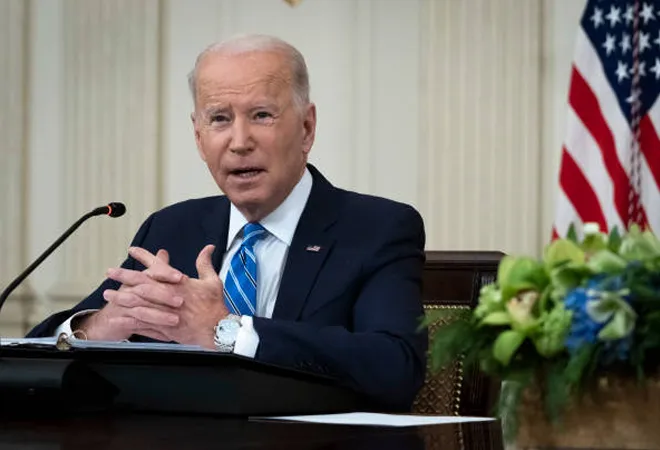
This article is part of the series — Colaba Edit.
In his bid for the US presidency in 2020, President Joe Biden campaigned on a restorationist agenda towards “rescuing US foreign policy” from his predecessor Donald Trump’s ‘America First’ approach. Under the Trump presidency, that approach had devolved into ‘America Alone’ on the back of the open derision of Washington underwriting the security of its allies. In Asia, however, Trump’s ‘America First’ impulses stood tempered in view of his administration’s sustained confrontational posture against China and an emergent US bipartisan consensus on addressing the strategic threat posed by Beijing’s rising influence in the region. Under the aegis of his administration’s Indo-Pacific strategy, which interlinked the destinies of the Indian and Pacific Oceans, Trump built on Barack Obama’s ‘Pivot/Rebalance to Asia’ policy.
With respect to the US’s partnerships in the region, Trump’s record reflected little deviation from US foreign policy precedents. For instance, with traditional allies like Japan and Australia, Trump honed a constructive record by upholding Obama-era commitments like reaffirming the US-Japan alliance’s purview over contested entities and the completion of targets set for rotational US troop presence in Darwin. Meanwhile, with nascent US partners like India and Vietnam, Trump paved the way for increased US support for their naval capacity-building and finalised new security commitments, in contrast to his abhorrence for institutionalised security partnerships.
Beyond Trump’s constructive record with US partners in the Indo-Pacific, his administration’s economic policy towards the region could inform policy continuity under Biden.
Hence, as Biden committed to “restore our historic partnerships,” the Indo-Pacific emerged as an oddity — albeit a welcome one — with little divergence between Trump’s record and Biden’s propositions. Since winning the election, however, Biden has distanced himself from Trump’s Indo-Pacific nomenclature, perhaps in an effort to cultivate political elbowroom on exploring a conciliatory policy towards China.
However, beyond Trump’s constructive record with US partners in the Indo-Pacific, his administration’s economic policy towards the region could inform policy continuity under Biden.
‘Economic pillar’ of Trump’s Indo-Pacific strategy
Trump’s withdrawal from Obama’s flagship Trans-Pacific Partnership often dominates analyses on the US’s standing in the region’s economic landscape, with Washington said to have ‘dropped the ball’ on the much-touted “Asian century.” Biden too deemed Trump’s decision to have “put China in the driver’s seat” on setting the “rules of the road.” However, on shaping the region’s economic future, Biden will inherit the “economic pillar” of Trump’s Indo-Pacific strategy, which furthers “market-based economic systems, private sector finance, and open investment environments.”
The Trump administration established the Blue Dot Network (BDN) to underscore the high standards of investments by the US and its partner nations, in contrast to China’s ‘debt-trap’ machinations under the Belt and Road Initiative. In providing a “globally recognised seal of approval signifying adherence to high standards,” the BDN’s push for market-driven, transparent and financially sustainable infrastructure projects also stands in-line with Japan’s G20 leadership on crafting the ‘Principles for Quality Infrastructure Investment.’
On shaping the region’s economic future, Biden will inherit the “economic pillar” of Trump’s Indo-Pacific strategy, which furthers “market-based economic systems, private sector finance, and open investment environments.”
This was coupled with the Better Utilisation of Investments Leading to Development (BUILD) Act of 2018, whereby the Trump administration established the US International Development Finance Corporation (DFC). With a US$ 60 billion budget, the DFC seeks to “mobilise and facilitate the participation of private sector capital and skills in the economic development” of developing nations. By September 2020, the DFC had over 200 projects in the Indo-Pacific with finance/investment fund/technical development commitments worth US$ 5.4 billion, swiftly becoming the central entity on bridging development assistance aims with US foreign policy goals.
In 2018, the Trump administration launched the Asia EDGE initiative to take advantage of the Indo-Pacific’s energy market, which is set to account for nearly 60 percent of global growth in energy demand by 2040, by mobilising/commissioning investment in energy infrastructure in rising economies like Indonesia, Bangladesh and Vietnam. The US also announced investments to support “free, open, stable, rules-based regional electricity markets” in Mekong countries.
The Trump administration’s effort to shape the region’s economic future was coupled with a trade approach, which will fit squarely with Biden’s intended foreign policy for the working class.
Biden internalises ‘America First’ approach
Biden’s continuity on several initiatives will largely stem from his commitment to once again have the US embrace multilateralism and a reinvigorated sense of US bipartisanship that underpinned some Trump-era efforts (such as the prompt passage of the BUILD Act). In addition, policy continuity on the Indo-Pacific will also stem from the Biden campaign’s commitment to pursue a foreign policy to make the “lives of working people better, safer, fairer.”
Biden’s policy will mirror Trump’s approach. After all, it was Trump’s 2016 victory that underscored the electoral centrality of the working class and his ‘America First’ foreign policy served as a belated awakening for the US foreign policy establishment to also cater to domestic priorities.
While some may attribute this turn to nativism to the broad decline in the political currency of US internationalism, Biden’s policy will mirror Trump’s approach. After all, it was Trump’s 2016 victory that underscored the electoral centrality of the working class and his ‘America First’ foreign policy served as a belated awakening for the US foreign policy establishment to also cater to domestic priorities.
On Trump’s record in the Indo-Pacific, consider his administration’s aims under the Asia EDGE initiative. With about 30 percent of all US energy exports (worth US$ 50 billion in 2018) heading to the Indo-Pacific region, it was no secret that the initiative stood in tandem with the Trump administration’s aim of “unleashing American energy dominance.” Beyond gains for energy infrastructure in the Indo-Pacific, the Asia EDGE initiative thus, also seeks to further tap into the potentialities of the region’s energy market. At the same time, this opening up of “new export opportunities for American energy producers” protected jobs in the US energy sector in line with Trump’s 2016 campaign promise.
With Trump overseeing the US’s rise as the “world’s largest energy producer” and a “net exporter of oil,” it will be difficult for Biden to ignore the foreign policy advantage accorded by that distinction. Hence, although Biden has committed to a progressive energy policy to regulate the oil industry and favour cleaner fuels, he has often reflected pragmatism, such as on his position on fracking. With that mode of extraction being adopted in 95 percent of the oil and gas wells drilled in the US, even minor political shifts on the matter could hold major consequences for jobs in the sector. It is, therefore, unlikely that Biden’s “middle class” foreign policy will encompass a complete reversal of Trump’s energy policy in the Indo-Pacific and beyond.
Similarly, Biden’s ‘Build Back Better’ plan for jobs and economic recovery aligns with Trump’s focus on improving market access for US businesses and thereby cultivating gains for the US manufacturing base.
It is unlikely that Biden’s “middle class” foreign policy will encompass a complete reversal of Trump’s energy policy in the Indo-Pacific and beyond.
The Trump administration facilitated the entry of over 9,000 US companies in the Indo-Pacific, through the Indo-Pacific Business Forum, for additional exports worth US$ 7.65 billion. Furthermore, by pushing the US Congress to restore the mandate of the US Export-Import Bank, Trump oversaw the clearance of additional US exports worth about US$ 40 billion, which ostensibly support nearly 230,000 jobs.
Hence, given Biden’s own tempering of US internationalism with his foreign policy for the working class, his economic policy for the Indo-Pacific will largely continue on the path paved by Trump’s ‘America First’ approach.
The views expressed above belong to the author(s). ORF research and analyses now available on Telegram! Click here to access our curated content — blogs, longforms and interviews.




 PREV
PREV


